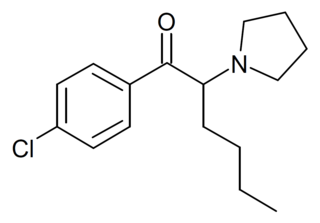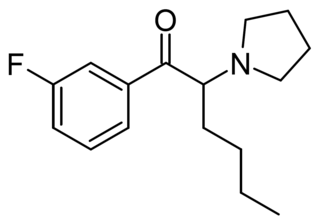
4'-Methyl-α-pyrrolidinopropiophenone is a stimulant drug and substituted cathinone. It is structurally very similar to α-PPP, with only one added methyl group in the para position on the phenyl ring. 4-MePPP was sold in Germany as a designer drug in the late 1990s and early 2000s, along with a number of other pyrrolidinophenone derivatives. Although it has never achieved the same international popularity as its better-known relations α-PPP and MDPV, 4-MePPP is still sometimes found as an ingredient of grey-market "bath salt" blends such as "NRG-3".

Naphyrone, also known as O-2482 and naphthylpyrovalerone, is a substituted cathinone drug derived from pyrovalerone that acts as a triple reuptake inhibitor, producing stimulant effects and has been reported as a novel designer drug. No safety or toxicity data is available on the drug.

Substituted cathinones, which include some stimulants and entactogens, are derivatives of cathinone. They feature a phenethylamine core with an alkyl group attached to the alpha carbon, and a ketone group attached to the beta carbon, along with additional substitutions. Cathinone occurs naturally in the plant khat whose leaves are chewed as a recreational drug.

α-Pyrrolidinohexiophenone is a synthetic stimulant drug of the cathinone class developed in the 1960s which has been reported as a novel designer drug.

3',4'-Dimethoxy-α-pyrrolidinopentiophenone is a synthetic stimulant drug of the cathinone class that has been sold online as a designer drug. It is a relatively weak inhibitor of serotonin reuptake and has little affinity in vitro for dopamine or noradrenaline transporters.

Mexedrone is a stimulant and an entactogen drug of the cathinone class that has been sold online as a designer drug. It is the alpha-methoxy derivative of Mephedrone.

4'-Fluoro-α-pyrrolidinopentiophenone is a stimulant drug of the cathinone class which has been reported as a novel designer drug.

5-DBFPV is a stimulant of the cathinone class that has been sold online as a designer drug. It is an analogue of MDPV where the methylenedioxyphenyl group has been replaced by dihydrobenzofuran.

4-Chloro-alpha-pyrrolidinovalerophenone is an emerging recreational designer drug of the pyrrolidinophenone class, similar in structure to alpha-pyrrolidinopentiophenone (α-PVP). The pharmacology and toxicity of this compound is unknown, though it is presumed to be a stimulant drug.

N-Ethylhexedrone (also known as α-ethylaminocaprophenone, N-ethylnorhexedrone, hexen, and NEH) is a stimulant of the cathinone class that acts as a norepinephrine–dopamine reuptake inhibitor (NDRI) with IC50 values of 0.0978 and 0.0467 μM, respectively. N-Ethylhexedrone was first mentioned in a series of patents by Boehringer Ingelheim in the 1960s which led to the development of the better-known drug methylenedioxypyrovalerone (MDPV). Since the mid-2010s, N-ethylhexedrone has been sold online as a designer drug. In 2018, N-ethylhexedrone was the second most common drug of the cathinone class to be identified in Drug Enforcement Administration seizures.

MDPHP (3',4'-Methylenedioxy-α-pyrrolidinohexiophenone) is a stimulant of the cathinone class originally developed in the 1960s, which has been reported as a novel designer drug. In the UK its slang name is monkey dust. It is closely related to the potent stimulant MDPV though with slightly milder effects, and has been used as an alternative in some countries following the banning of MDPV.

α-Pyrrolidinoheptaphenone is a designer drug of the pyrrolidinophenone class of cathinones. It is the higher homolog of α-pyrrolidinohexiophenone (α-PHP).

α-PHiP, is a stimulant drug of the cathinone class that has been sold online as a designer drug. It is a positional isomer of pyrovalerone, with the methyl group shifted from the 4-position of the aromatic ring to the 4-position of the acyl chain. In a classic 2006 study of pyrrolidinyl cathinone derivatives by Meltzer et al. at Organix, the alpha-isobutyl derivative of pyrovalerone, O-2494, was found to have the highest potency in vitro as an inhibitor of the dopamine transporter of the alpha substituted derivatives tested; however, it was not until ten years later in July 2016 that α-PHiP was first identified as a designer drug, when it was reported to the EMCDDA by a forensic laboratory in Slovenia.

TH-PVP is a substituted cathinone derivative which has been sold as a designer drug. It was first identified by a forensic laboratory in Hungary in 2015, but has subsequently been found in numerous other countries around the world including Spain, Belgium, Poland, Turkey and Brazil. Pharmacological studies in vitro showed it to inhibit reuptake and promote the release of monoamine neurotransmitters with some selectivity for serotonin, but it failed to produce stimulant effects in animals, and has a pharmacological profile more comparable to that of sedating empathogens such as MDAI and 5-Methyl-MDA.

3F-PiHP (3F-α-PHiP) is a recreational designer drug from the substituted cathinone family, with stimulant effects. It was first identified in both Sweden and Finland in mid-2019, and was made illegal in Finland in August 2019.

3-Fluoro-α-Pyrrolidinovalerophenone (3F-PVP) is a recreational designer drug from the substituted cathinone family with stimulant effects, which first appeared on the illicit market in around 2018. It is illegal in Finland.

MFPVP (3-Methyl-4-fluoro-α-pyrrolidinovalerophenone) is a recreational designer drug from the substituted cathinone family, with stimulant effects. It was first identified in Sweden in April 2020 and was among the most widely encountered substituted cathinone derivatives in 2021, though it since appears to have declined in prevalence. It is illegal in Virginia.

4-Chloro-alpha-Pyrrolidinohexiophenone (4-Cl-PHP) is a substituted cathinone derivative with stimulant effects, which has been sold as a designer drug. It was first officially identified by forensic laboratories in 2016, though anecdotal reports suggest it may have been available several years prior to this.

3-Fluoro-alpha-PHP (3F-PHP) is a substituted cathinone derivative with stimulant effects which has been sold as a designer drug. It was first identified in Sweden in 2020 and continues to be detected in seized drug samples, though it appears to have been less widely used than related compounds such as 3F-PVP and 3F-PiHP.



















